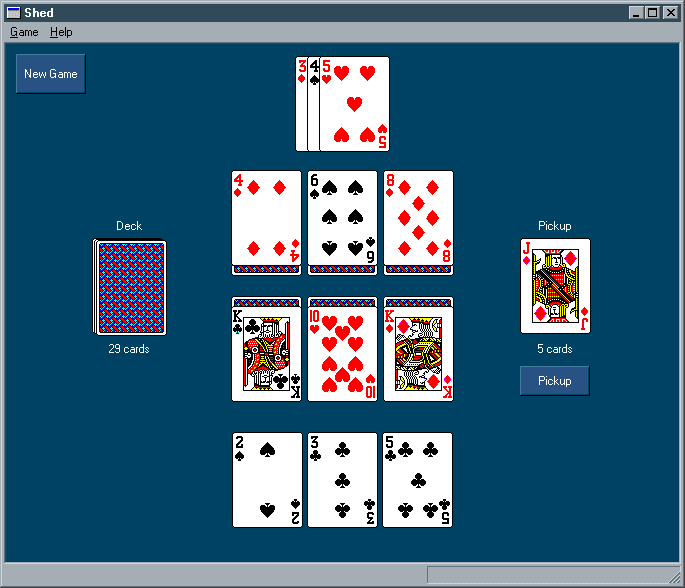Shed is a single player card game for all 32bit versions of Windows. It is based on the popular student card-game of “Shit-head”, which I believe is sometimes known as “Shit-boots” in America. It gets its name due to the profanity that is usually voiced when someone wins the game.
This version of the game allows you to re-create those chaotic games of Shed by playing against a computer opponent. I didn’t think there’d be much use in a two-player or multi-player version, as this game is best played with a real deck of cards.
How to play Shed
The goal of Shed is to win by being the first to play all of your cards.
A standard deck of 52 cards is used to play a game of Shed. Nine cards in total are dealt to each player before the play starts. The first three cards are always dealt face-down in front of each player. These three cards cannot be viewed until the last stage in a game. The other six cards are dealt to the player’s hand. Before the game starts, the player must choose three of these cards to be placed face-up on top of the first three cards. The remaining three are your hand. Once you and the computer has laid out your cards, play can begin by clicking on the “Start” button.
You must each take it in turns to play a card(s) from your hand on to the pickup pile. There are two basic rules you must adhere to when playing a card:
- You must always play a card which has the same or a higher value than the card currently at the top of the pickup pile.
- You can play more than one card at a time as long as they are the same value.
In addition to these two basic rules, there are nine other rules which complete the game of Shed.
- You must pickup the contents of the pickup pile if you cannot play a card.
- You must always have at least three cards in your hand.
- Once you play a card, you must refill your hand from the deck.
- Aces are always high.
- Two’s can be played on top of any card, and in effect reset the top card to the lowest possible value.
- Ten’s can be played at any time, and clear the pickup pile when played.
- If a Ten is played, then the player is allowed another go.
- Seven’s can be “see-through” cards - they are ignored when a card is played on top of them, and the card underneath the seven is used as the top card.
- If four cards of the same value are played consecutively, or at the same time, then the pickup pile can be discarded. The player to put the last card down in this series is allowed another go.
Once there are no more cards in the deck, and your hand is empty, then you may select one or more of the face-up cards that you put aside at the start. You can play one or more cards from the face-up cards, as long as they are the same value. Tip: to play more than one card, drag the cards on top of each other to make one pile before you play them onto the pickup pile.
Once the three face-up cards have been played, you may finally play the three face-down cards. You must play these one at a time, and you cannot look at any of the cards before playing them. If the card you select is too low to play, then you must pickup the card and also the pickup pile.
The player who gets rid of his cards first is the winner of the game.
Supported Platforms:
Windows 95, 98, ME, Windows NT 4.0, 2000. Requires common controls library 4.x or greater.
